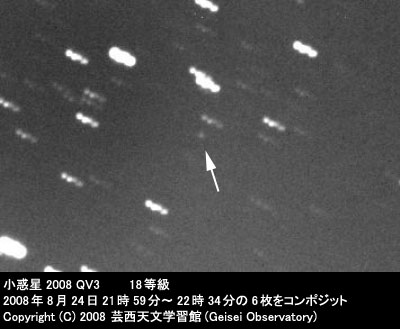August 31
First minor planet discovery by Project Geisei
Since the completion of the new 70cm reflecting telescope
and subsequent establishment of Project Geisei undertaken by Muraoka, Shimomoto,
and Seki, the first substantial achievement was accomplished by the discovery
of minor planet 2008 QV3. This is a faint minor planet found on August
24 during the patrol with the 70cm telescope. It was observed the following
day (August 25) and its provisional orbit was calculated by Mr. Syuichi
Nakano and reported to the Minor Planet Center. It is the first success
in so many years at Geisei and was made possible by the efforts of Mr.
Shimomoto, Mr. Muraoka, and others. There aren't many minor planets brighter
than the 19th magnitude and I believe this discovery owes to the large
aperture of the 70cm telescope.
It is reported that Ishigakijima Astronomical Observatory discovered a new minor planet around the same time. When I visited the observatory to give a public lecture last summer, I told the audience that the location of this southern island would be advantageous for discovery of new objects in summer. I selfishly thought this could have contributed to their discovery.
We are hopeful that this newly discovered object will be
observed for many years to come and given an official number leading to
the naming of this minor planet.

Minor Planet 2008 QV3, 18th magnitude
Composite of 6 images exposed between 21:59 and 22:34 on August 24, 2008
August 21
In old days in Kochi, the Bon festival (an annual festival
to welcome ancestral spirits back to family altars) was celebrated according
to the lunar calendar. It was around this time of year or a little later.
On the day of welcoming or sending off the family ancestors, a torch was
lit at the front gate at night to celebrate the festival. Late at night,
when the torch of pine was about to burn out, we would begin to feel cool
autumn breezes. The following is a story from those old days when Bon torches
were lit at the front gate.
On warm summer nights, neighbors would bring out their benches
onto the street in front of their homes and gossip away till late while
cooling themselves with fans. On one such night, an elderly person found
a comet in the western sky. It caused an excitement among the people who
gathered there. According to them, they saw a comet, 2 feet long, in the
mid-altitude western sky straight ahead of the street. The comet glowed
like a will- o-the-wisp (ignis fatuus) in a bluish color and did not disappear
until late at night. Around the benches they would talk about politics,
what's happening around them, their discontent about life, and finish off
with horror stories and chats about starry nights. But that night, the
appearance of the comet added to the nightly entertaining stories.
This comet was no other than Mrkos (C/1957 P1), which was
discovered in early August that year (1957). Comet Mrkos suddenly dominated
the morning sky as a naked-eye comet, and then it reappeared majestically
in the evening western sky. I understand that the first discoverer of this
comet is Mr. Kuragano living in Yokohama. He found a comet trailing a faint
tail in twilight with the naked-eye, while he was waiting for the sunrise
at the 8th station of Mt. Fuji in late July, 1957. Later, he reported the
sighting to Tokyo Astronomical Observatory. Among those who knew the discoverer
of this comet, it was known for a while as Comet Kuragano. This reminds
me of the eclipse comet of 1948. It was at first called comet McGann, the
name of the American pilot who had discovered this comet.
August 15
This is mid August, but summer is still firmly with us. Since
August 11, I have been looking out for the Perseid meteor shower and I
wonder when it reached the peak. I haven't seen any noticeable increase.
I began observation late on August 14. Around 3:30 am on
the following day, I witnessed a 6th-magnitude fireball in the northern
sky. It lasted for only 0.7 seconds, but lit up the sky and surrounding
landscape.
I remember that on the morning of August 13, 1950, when I
started comet search for the first time, I saw a tremendously bright fireball
belonging to the Perseid shower. It was so bright as if a half moon had
suddenly appeared. I clearly saw my shadow cast on the ground. If I had
happened to see that fireball directly, I would have found it an awesome
sight. A scale-like trail of the fireball was hanging in the air quite
clearly for some time in the southern sky. I felt an eerie sensation and
thought it could be an omen predicting a rough time for my future comet
search. Surely, for the next 10 years I experienced turbulent, tumultuous
years of comet search.
The Milky Way in the northern sky looked like sprinkled silvery
sand and the Andromeda Galaxy was clearly visible to the naked eye. It
was still summer on the ground, but up in the heavens autumn was at its
peak.
At a little before 4 am, the autumn zodiacal light faintly
colored the eastern sky pale, narrow and long, though it was still August.
This mystical light is still present unaffected in the sky over Geisei.

A fireball of the Perseid meteor shower
3:30 August 15, 2008
Nikon FM 28mm f/2.8 Plest film


